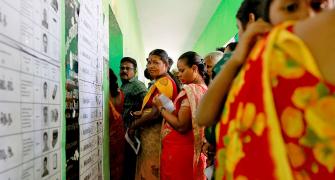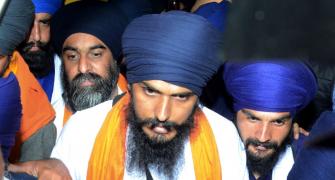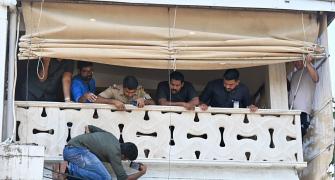Consolidation imperative
K V Krishnamurthy, Ex-CMD, Bank of India
The name Monetary & Credit Policy is a misnomer. It is time to leave the aspect of credit creation to the banking system and concentrate on monetary policy.
Luckily, with changes in style and substance, we now don't have to wait six months for changes in the cash reserve ratio, statutory liquidity ratio and interest rates.
Such changes now come through debates, speeches and often hidden in circulars here and there. As I look back and forward to the next policy, certain things come to my mind.
The Reserve Bank of India's response to rising inflation during the past two quarters has been less than prompt. Inflation is now a primary concern of all monetary authorities.
Nowhere does it hurt the poor more than in India. We have been hiding under phrases like 'core inflation', 'oil inflation' and so on but for the poor it doesn't matter where it comes from.
The fear that impacting liquidity may effect interest rates has to go. No doubt, there will be pressures from business lobbies and a friendly nudge from the government to keep interest rates down (to manage fiscal deficit) but this is not a good enough reason to turn a blind eye to the raging inflation. The RBI should have suck out the liquidity much earlier and at least sent a signal by increasing the bank rate.
The interest rates, well below the rate of inflation, have created a situation of negative real interest rates. With a large chunk of savers now coming from the rural and semi urban sector, rural India is now subsidising urban rich.
The RBI should keep at the back of its mind that banks are conditioned to hand holding and it may take some more time to act on their own on interest rates from the perspective of inflation.
Another issue is the slow response to the crumbling finances of the co-operative banking structure and the regional rural banks. A vigorous response is now required. The central bank needs to look at the foreign and private sector banks also who are handled with kid gloves.
The Global Trust Bank experience and many before that have shown that everything is not well there. We will have to provide level playing field to public sector banks instead of forever keeping them under pressure.
The high forex reserves are now taking a toll on the economy. Liquidity derived out of such funds is creating liquidity pressures domestically. The comfortable forex position has continued long enough to think of greater push to capital account convertibility.
A major initiative is now overdue in banking sector reforms. The push for merger of banks has to come now or it will be too late. Though banks in India have been showing good profits, it cannot be forgotten that this is mainly a product of gains made from investments and falling interest rates.
With rates bound to rise, banks would find it difficult to maintain profitability. I hope RBI makes use of this time available to put public sector banking on a sound platform.
Finally, I hope we don't have to endure through more micro level schemes which are thrust on the banking system. Playing to the gallery in the past has done enough damage to the economy.
Bank rate, CRR hike unlikely
Shailendra Bhandari, Managing Director, Centurion Bank
With inflation running close to 8 per cent, this is not going to be an easy one. On the one hand, there is pressure from the "supply side" on prices, typified by the price for oil quoting close to $ 50 per barrel. This is not being helped by what has been at best a below normal monsoon.
On the other hand, there is a sudden pick up in credit demand with total bank credit having increased by Rs 70,654 crores (Rs 706.54 billion) till early September (compared with only Rs 4,622 crores last year).
Add to that some weakness in the rupee and an international hardening of interest rates, and then throw in concerns on some parts of the banking sector, the problem gets truly complex.
The response so far has been a mixture of fiscal controls (reducing of duties on petroleum products) and monetary (a two- step increase in CRR), with no discernible effect as yet.
The problem gets more complicated now because there is probably not a whole lot more that can be done on the fiscal side. As of end-august the revenue deficit had crossed 82.6 per cent of the full year target, though the fiscal deficit was somewhat better at 38.2 per cent of the target.
The onus will be squarely on monetary policy for getting inflation under control. The quandary lies in the fact that while the RBI can reduce money supply to some extent without influencing interest rates, this has probably already reached its limits.
Any further tightening is likely to see an increase in rates to the borrowers and a decline in bond prices, which will certainly affect those banks who have been relying on treasury profits to shore up their incomes over the last few years. What can we expect? At the very least the governor will talk tough. We are likely to see some or all of the following:
-
A change from the present stance for a "soft and flexible interest rate environment" to a more neutral stance, or even with a bias towards tightening.
-
Given the below normal monsoon a possible downward revision in the GDP outlook from 6.5-7.0 per cent to say around 6 per cent.
-
A possible upward revision in the inflation outlook from the current 5 per cent.
On matters other than monetary policy, a reiteration of the importance of agricultural lending, once again in keeping with the government policies.
We would expect some serious attention to the problem of restructuring of co-operative banks. The policy statement of the RBI issued in May had highlighted the need for a scheme for this, and we would expect further fleshing out, especially given the spate of co-operative banks that have recently run into trouble.
What we do not expect this time is an immediate change in the interest rate structure, or any immediate additional change in CRR. Certainly the bank rate which has become largely symbolic is unlikely to be changed from the current 6 per cent. At best, we may just see a 25 basis point increase in the Repo rate from 4.5 per cent to 4.75 per cent.
Finally, whether talking tough will prove sufficient by itself will become clearer only over the next few months. With a bit of luck, oil prices may drop off dramatically, and credit demand may start to slacken by itself. Otherwise, this will only prove to be a postponement, and we will see higher interest rates by early next year.







